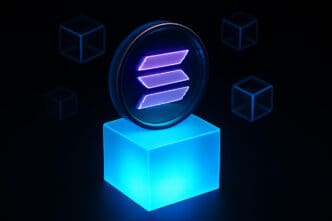Executive Summary
- BlockchainFX (BFX) has successfully raised over $11 million in its presale and secured an official license from the Anjouan Official Finance Authority (AOFA).
- The BFX ecosystem features a staking system allocating 70% of trading fees to rewards, buybacks, and token burns, alongside a multi-asset trading platform for cryptocurrencies, stocks, forex, and ETFs.
- BFX aims to differentiate itself from competitors like Solana and Sui by focusing on financial stability through structured incentives, staking rewards, and practical utility, including a presale-exclusive Visa Card.
The Story So Far
- The broader cryptocurrency market faces challenges such as volatility and reliability issues, as seen with platforms like Solana experiencing network outages and Sui grappling with limited adoption, creating an opportunity for new projects to offer more stability and utility. BlockchainFX (BFX) is capitalizing on this by securing regulatory licensing, implementing a deflationary token model with staking rewards, and developing a multi-asset trading platform with practical features like a crypto-enabled Visa card, aiming to attract investors seeking a more robust and dependable decentralized ecosystem.
Why This Matters
- The successful $11 million presale and regulatory license from the Anjouan Official Finance Authority significantly enhance BlockchainFX’s credibility and investor trust, positioning it as a serious contender in the crypto market. Its integrated ecosystem, offering substantial staking rewards, a deflationary token model through buybacks and burns, and a multi-asset trading platform with real-world spending utility via a Visa card, aims to attract investors by providing a blend of financial incentives, stability, and practical usability, potentially carving out a niche against established platforms like Solana and Sui.
Who Thinks What?
- BlockchainFX (BFX) asserts that its successful $11 million presale and official license from the Anjouan Official Finance Authority position it as a stable, innovative contender in the crypto market, offering investor trust, utility, and financial incentives through its staking system and deflationary model.
- Solana is recognized for its high-speed and scalable architecture, yet its consistent long-term reliability is questioned due to repeated network outages and price fluctuations.
- Sui is noted for its innovative object-centric blockchain design, but its limited adoption and evolving ecosystem lead to uncertainty regarding its real-world application and long-term scalability.
BlockchainFX (BFX) has announced that its presale has successfully raised over $11 million, coinciding with the news that the platform has secured an official license from the Anjouan Official Finance Authority (AOFA). This development positions BFX as a new contender in the crypto market, aiming to offer a blend of innovation, utility, and stability, with its token currently priced at $0.03 and targeting a $0.05 launch.
BFX Presale and Regulatory Milestone
The BFX token presale has garnered significant investor confidence, accumulating over $11 million. The token’s price is structured to increase with each completed presale tier, providing an incentive for early participation.
A notable achievement for BlockchainFX is its licensing by the Anjouan Official Finance Authority (AOFA). This regulatory approval is highlighted as a significant milestone, potentially enhancing investor trust and supporting the project’s long-term stability.
Ecosystem and Utility
The BlockchainFX ecosystem is designed around a staking system that aims to generate passive income for investors. Seventy percent of trading fees are allocated to staking pools, buybacks, and token burns, with stakers receiving 50% of these fees in BFX or USDT, potentially earning up to $25,000 USDT daily.
Furthermore, 20% of fees are used for buying back $BFX tokens from the market, with half of these tokens permanently burned. This mechanism is intended to create a deflationary cycle, reduce token supply over time, support price growth, and reward long-term holders.
BlockchainFX’s decentralized platform facilitates trading across various asset classes, including cryptocurrencies, stocks, forex, and ETFs. This multi-asset approach aims to bridge traditional and decentralized finance, offering a “super app” experience within a single platform.
Adding to its utility, BlockchainFX offers a presale-exclusive Visa Card, available in Metal and 18 Karat Gold editions. This card supports over 20 cryptocurrencies, allows transactions up to $100,000, and enables monthly ATM withdrawals up to $10,000, allowing stakers to spend BFX and USDT rewards globally.
Market Positioning Against Solana and Sui
The article draws comparisons between BlockchainFX and established platforms like Solana and Sui. Solana is recognized for its high-speed transaction processing and scalable architecture, though the piece notes that repeated network outages and price fluctuations have raised questions regarding its consistent long-term reliability.
BlockchainFX, in contrast, aims to mitigate volatility through its structured presale incentives, staking rewards, and deflationary model, suggesting a focus on financial stability alongside technological offerings. Sui is highlighted for its innovative object-centric blockchain design, but the article points to limited adoption and an evolving ecosystem, which may lead to uncertainty regarding its real-world application and long-term scalability.
BlockchainFX seeks to differentiate itself by delivering immediate traction through its presale success, clear staking mechanics, and a roadmap for multi-asset trading and spendable rewards. The platform emphasizes tangible value and structured growth as key attractions for investors.
Outlook for BFX
As Solana and Sui continue to develop their platforms, BlockchainFX is positioning itself by providing immediate financial incentives and practical utility. The project aims to offer investors a comprehensive decentralized ecosystem that combines passive income generation, potential price appreciation, and real-world usability.








